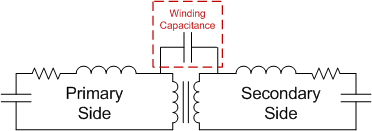SLVAE50A February 2019 – April 2022 ESDS302 , ESDS312 , ESDS314
2.2 Isolating Transformer
Having the transformer in the system means that there is isolation between Ethernet wires such as CAT-5 or CAT-6 and the Ethernet controller or phy. Transformers however do have parasitic elements associated with them. Figure 2-2 shows the different parasitic elements present in a transformer specifically highlighting one that is the culprit for why there is not full isolation in a transformer. On both the primary and secondary side of the transformer there is a parasitic capacitance, resistance and inductance that is present in all real world small signal analysis. These are due to the nature of the material and their proximity to each other. However with having both the primary and secondary wound next to each other, there is a winding capacitance introduced.
 Figure 2-2 Transformer Schematic with Parasitics
Figure 2-2 Transformer Schematic with ParasiticsEquation 1 is the equation for a current through a capacitor. Since the surge pulse is providing a large dV/dt on the primary side, the capacitor will have current flow from the primary side to the secondary side but not fully isolating the two sides. This pulse seen on the secondary side is a percentage of the primary side which at high levels can easily damage IC connected. Therefore this pulse must be measured and protected against.